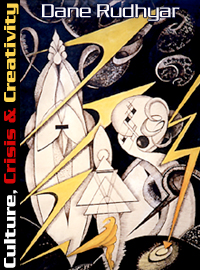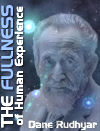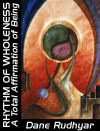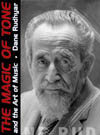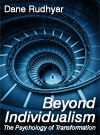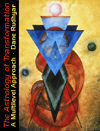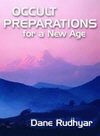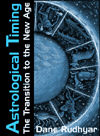Culture, Crisis & Creativity
by Dane Rudhyar
4. Toward a Companionate Order
of Relationship
The process of civilization brings to the field of human activity in which culture-wholes operate a radically new approach to interpersonal and group relationships. This approach is responsible for the most basic features of the transformation which humanity as a whole, and particularly our Western society, is partially experiencing; but most people fail to understand at its deepest level the difference between the ways in which interpersonal relationships operate, on the one hand in tribal groups of cultural societies living close to nature, and on the other hand in the lives of human beings who, having achieved a relatively individualized state of consciousness, come together for the purpose of gradually realizing a deliberately chosen ideal of life.
In order to elucidate the character of this difference, let us mentally picture two gatherings of human beings. In the first case, a close family group in a conservative European or American town is found at Christmas time around a tree laden with presents. These people are related by kinship; they speak the same language; the same religious, cultural, and geomagnetic influences have molded their personal development. They are now exchanging gifts in a loving traditional spirit, rejoicing in a quasi-instinctual communion of feelings arising from a common rootedness in a collective past. Whether or not they are aware of such a grounding in a past, it is that sameness of origin that psychically unites them. It acts as a more or less compulsive force which operates underneath and through the more conscious feelings of personal likes or dislikes.
In the second case, we have a meeting of delegates at the United Nations headquarters discussing an international problem. Here we see educated individuals coming from different continents, races, creeds, and cultures, yet intent on working for the realization of a common purpose through days and nights of deliberation and compromises. In the end, a formula may emerge which will solve a crucial international problem and establish a more lasting peace.
The family gathering at Christmas is marked by the basic similarity of all the participants. The United Nations meeting reveals at first seemingly unresolvable individual differences; yet these differences may become harmonized and, ideally, an integrating solution acceptable to all should be reached. In the first instance unity is a primary fact which precedes the meeting and underlies the collective mood it produces. It is "root unity." The functional activities operating within living organisms are rooted in that kind of unity; all such organisms originate in one common ancestral cell, a seed or fecundated ovum. In the second instance, we start with basic differences; unity is at first only an ideal and an often distant goal which may or may not be realized. When realized we should speak of "multiunity"—or, in the recently popularized phrase, "unity in diversity"—rather than of simple and singular unity. This potential state of multiunity requires constant effort and vigilance for its implementation and maintenance. It can never be taken for granted.
Unity achieved at the group level as the outcome of a difficult process of harmonization of individual differences has assuredly not the same character as unity resulting from an initial sameness or basic biological similarity. While in the latter case the relatedness of a multiplicity of persons is the result of a process of differentiation which began in unity, in the United Nations group we see at work a process of integration which, it is hoped may end in the establishment of a single world-community. Such a process can be seen operating also, but in a somewhat different manner, in the type of communities formed by people of perhaps different races, cultures, and religious backgrounds, who have come together in order to work for the establishment of a type of society that would operate at a higher level of inclusiveness and consciousness. In such a community the actual patterns of organization and the implications of a new society may not be clearly envisioned by many of the participating individuals, yet the basic feeling that a new type and quality of interpersonal relationship can be worked out serves as an integrative force producing a union.
The envisioning of an ideal democracy by free thinkers of the eighteenth century and some of the founders of the United States when speaking of liberty, equality, freedom of opinion and association, and justice for all, was an attempt to demonstrate the possibility for human beings of various races, cultures, and religions to come together for the avowed purposes stipulated in the Preamble to the Constitution.(1) When a truly democratic society is consistent in its everyday application of what it officially professes, a common purpose should orient the consciousness and the actions of all its citizens and draw them toward the future. This future is not "given"; it has to be created. The vision of the ideal goal must be constantly upheld by the members of the community - at the local as well as the national level—as something that is yet to be fully realized, for quite obviously its realization is, at best and for a long time, partial and subject to reverses and crises of readjustment. Such a community should have an essentially dynamic character, because it should never take perfection for granted. Because it did not begin in actual physical unity, but in diversity of backgrounds, the only essential unifying principle must be the common goal; and this fact should polarize all the interpersonal relationships operating in that community and define their character. They should be deliberate and purposeful, because the joining of individual lives and efforts should be dedicated to the task of actualizing and substantiating what is as yet only a future possibility.
Such a type of interrelating is fundamentally different from that operating in tribal societies. These societies may be dynamic, at least during the first periods of their life-span, but what is at work is a dynamism of growth. The germinal impulse unfolds its inherent genetic potentialities. Everything is given in principle. A unity of origin differentiates into a multiplicity of cells according to a prearranged structural plan. The only basic uncertainty is whether or not the gradual development of the tribe and its culture proceeds correctly (right—rita in Sanskrit) according to the original seed-potential and the characteristic nature of the root-energy.
All tribal cultures speak of their Golden Age which they glorify in myths and rituals. It is the age of creative beginnings when gods or demigods walk with men. It is "sacred" time in contrast with "profane" time.(2) The latter refers to the type of growth-processes which are under our uncertain and often perverting control. Thus, a typical culture displays an inherent spiritual inertia, and so do all living organisms. The physical seed in the beginning will have to be reproduced in the equally physical seed in the end. The unfoldment of the plant may be a success or a failure, depending on environmental conditions and according to the manner in which the different human cells within the plantlike community or culture-whole fulfill their functions; but nothing can be expected to take place that was not potential in the divine act of creation in the beginning of time.
The type of order prevailing in tribal communities is what I shall call organic order. It is the order of life: biospheric order, biopsychic and cultural order. It is order rooted in the past, manifesting in organic growth, maturity, and decay: a cyclic type of order. In contrast to such a type of order, we can speak of a companionate order whose manifestations should be associated with the process of civilization(3) ; but, as already said, this process can be destructive as well as constructive, and its destructive aspect is particularly evident in the present-day megalopolis—the "tentacular," ever-spreading, and devouring city. Its constructive and transcendental aspect has been symbolized by the New Jerusalem and, in Asia, Shambhala.
The most characteristic manifestation of the companionate order has been exemplified in what has been called occult or universal Brotherhoods, a not too adequate designation as it uses a biological characterization "brother" to characterize a meta-biological and transcendental type of relationship. One of these occult Brotherhoods was the Druze Order founded in the 13th century by El Hamza. This Brotherhood united men and women of various races and religions who sought to build a spiritual community free from the religious conflicts of the period. The Druze Order operated in the Lebanon mountains of Syria, and Druze communities still exist today; but apparently much of the spiritual foundation of the Order has vanished under the pressures caused by the need for survival in a land constantly disturbed by religious conflicts and wars of conquest.
Last century an Asian sage defined a universal Brotherhood as "an association of 'affinities' of strong magnetic yet dissimilar forces and polarities centered around a dominant idea." Around the same time, the English art critic and philosopher, John Ruskin, stated the same concept in different words: "It is the great principle of brotherhood not by equality, not by likeness, but by giving and receiving; the souls that are unlike and the nations that are unlike being bound into one noble whole by each receiving something from and of the other's gift and the other's glory." And after World War I, a remarkably perceptive and idealistic American woman, M. P. Follet wrote in her book The New State: Group-organization, the solution of popular government: "Each must discover and contribute (to the group) that which distinguishes him from the other, his difference. The only use for my difference is to join it with other differences. The unification of the opposites is the eternal process." (4)
At about the same time the then highly controversial idea of "companionate marriage" was upheld by Judge Kinsey in a book which at the time became quite famous. It stressed the idea that marriage could validly be based on a revocable contract between a man and woman who deliberately agreed to unite their lives for a consciously held common purpose. This purpose could include the procreation of children as well as any other common goal, but the basic factor in this new type of marriage was that it was considered an association of two individuals who of their own accord and for purposes strictly of their own as individuals—and not as members of a biological family and a social or religious community, financial class, race, or nation—freely chose to work together.
We usually forget that until about one hundred years ago (and much more recently in many places) the choice of a marriage partner was almost never decided by a boy and a girl acting as individuals free from external parental and social or religious pressures. Marriage was a taken for granted event in the natural lives of normal men and women, and the two partners did not deliberately come together as individuals and for the purpose of achieving an individualized goal to which they were eager to consciously devote their joined lives. The one purpose of any marriage (except in rare instances) was to perpetuate the human race and a particular sociocultural and religious tradition endowed with a divine origin. To this "culture-marriage" we may therefore oppose a "civilization-companionship." The opposition is not to be thought of as absolute in terms of the physical, biological, and social consequences of the two types of man-woman union; these consequences may be outwardly the same in both cases, yet the intent and the essential character of the two participants radically differ in the two types of marriage. Not to realize what the difference is and how basic it is implies a failure to understand the difference between culture and civilization. And one can never sufficiently emphasize that without such a realization, the present all-human crisis cannot be given its true meaning.
Having said this, I must add at once that in our historical period most human beings respond in some degree to both types of order, organic and companionate. Human consciousness has for a long time resembled the mythical Roman Janus, one of whose two faces looked toward the past, the other toward the future. In Greek mythology we have also the twin brothers, Epimetheus and Prometheus, who can respectively symbolize the traditionalist oriented toward the past and the prophet whose vision seeks to pierce the as-yet-unknown future.
The pull of the biopsychic roots must be felt even by the "seed man" who is still attached to the plant of his culture. He can be free of that pull only when he has developed a mind and an experience of individual center allowing his transformed consciousness to leave the plant and, like a seed, to fall into the soil. Even then, as long as this culture-liberated individual operates in and through a physical body, he is still subject to the pressures and desires that characterize physical organisms within our biosphere. The two pulls coexist, and as a result conflict is unavoidable. Thus, a potential state of war exists within every individualized person; the biospheric self makes demands which the mental-spiritual self tries not to accept. Compromises are required if the unity of the personality is not to break down. Crisis follows crisis when new levels of adjustment between the conflicting forces become possible.
This sacred place is our consciousness; but in order to act as an alchemical vessel wherein the process of transformation can effectively operate, consciousness has to be individualized and formed. A place set apart and isolated from the mass-vibration of the culture-whole is required for the process to operate. The alchemical vessel—mind—has to be structured according to archetypal principles inherent in Humanity and in the universe to which we can relate. The consciousness of a particular human being has to be "formed" into a mind open to the above as well as to the below. Because, within this mind, the above and the below cannot only enter into contact, but can interpenetrate; it becomes a sacred place, an altar, an alchemical vessel. Only within such a formed consciousness can the symbolic union of Heaven (archetypal reality) and Earth (biopsychic human nature) occur.
It is in the minds of only a few individuals that the process of civilization acts upon the evolving culture-whole. Through these minds, and to the extent that the global state of the biosphere makes it possible at that particular time, civilization universalizes the culture of a particular group of human beings. What the creative minds are able to formulate in terms intelligible to the participants in that culture becomes then a mutating ideologic seed that, sooner or later, will germinate and affect other minds. By a process of mimesis, and more significantly of resonance, the latter in turn reproduce and multiply the new images and the new quality of relationship embodied in, or at least symbolized by these images and concepts.
We are dealing therefore with the interaction of two processes. The evolutionary biopsychic growth and eventual decay of a culture-whole is a continuous process; but at various times during its unfoldment, and especially as it reaches a stage of incipient degeneration, it is affected, and we might say fecundated, by a creative impulse emanating from centers of consciousness belonging to a far vaster planetary process. This process which I identify with civilization discontinuously releases into a few ready and open minds of culture-born persons new seed-ideas, symbols charged with an immense potentiality for transformation. New forms are visualized by the minds within which this metamorphic process of civilization has become, for a time, gradually focused—a time which operates in a different dimension from the time of our biosphere.
Form is the expression or concretization of relationship. Thus a new quality of relationship must inevitably produce new forms. Any basic change in the consciousness of human beings calls for a process of "trans-formation"—a process of metamorphosis. Because the life within the form develops a great deal of inertia, such a metamorphic process requires a concentration of energy, thus of energy-directing will. The release of energy produces motion and internal heat. The tremendous amount of energy released and heat produced in a hydrogen-bomb explosion is a fitting symbol of the crisis of transformation in which all human beings are now involved, whether or not they accept this fact and act intelligently and creatively in order to keep pace with the vast release of possibilities now open to mankind.
But how to keep pace, and where are we to go? The direction should be clear. It can be only toward the companionate order of relationship. First, the quality of interpersonal and intergroup relationships has to be changed so as to allow for a resonance of human consciousness to the consciousness of what is more-than-man—a metabiologizing of consciousness which transfigures the relationships of the life-sphere without, as in asceticism, violently belittling or repudiating them. Then, one must be open to the appearance of new forms concretizing the new character of relationships. But to be open to the advent of new forms, we should understand what is implied in the concept of form. We should grasp the meaning of the dualism of internal and external forms, of forms based on exclusion and forms demonstrating, at least in a relative sense, the character of all-inclusiveness. We should consider forms operating in terms of space and forms referring to the sequence of phases in processes inevitably implying time. We should understand the difference between "proportional form" and "expressive form"—a basic difference not only in the arts but in the art of living—forms derived from the differentiation or parceling of space, considered as fullness of being, and forms projected upon theoretically empty space by the emotions or the creative will of the artist. We could also discuss the meaning of form in the language of the modern physicist, and that of gestalt (or configuration) in twentieth century holism and psychology.
The subject is almost endless, for existence is relatedness, and the modes of existence are infinitely varied, each calling for a different approach to form. We shall therefore have to limit and restrict ourselves to those aspects of form which can reveal the operations of culture and civilization, particularly in the domain of the arts considered as a revelatory symbol of the organized activity of human communities.
At first the demands of the organic order cannot be dismissed. "Natural man" triumphs over "civilization man," and the ideal of metabiological and "noetic" existence according to the principles of the companionate order can but weakly challenge the power of the tribal roots. What is even more serious and eventually tragic is that the biopsychic drives of "natural man" succeed in using the mind that had envisioned a companionate ideal to satisfy their aim more excitingly. The deviated future-oriented drive becomes perverted and in turn it exacerbates and poisons the natural biopsychic energies. As this happens, the civilization process turns negative. It prostitutes itself. A totalitarian law-and-order worship—a brutal and obscene caricature of the companionate order— is gradually forced upon individuals rendered helpless by the products of a technology which have become the uncontrollable progeny of a civilization obsessed by materialism. Sadism and torture are accepted by a vast number of people as matters of no real consequence, even as matters of policy. Brutalizing civil wars rage, and when human beings refuse to unite in world-wide companionate love, their bloods have to unite on global battlefields. The symbolic (and probably also actual) battle of Kurukshetra described in the great Hindu epic, the Mahabharata, is to be fought again on a panhuman scale. The Biblical Armageddon may yet occur.
The blend of civilization and culture has innumerable destructive results, as long as the compulsive drives operating in a natural and balanced manner in the biosphere are able to intrude in the realm of the companionate order in a forceful and dominant manner. And they will intrude in a variety of unsuspected, confusing or lightly dismissed ways until the two principles of order and their corresponding levels of consciousness are not clearly distinguished and evaluated for what they are and are meant to be. But while coexistence must be a fact as long as human consciousness operates in a biological body, it is possible for any human being to alter, transform, and refine the quality of the results of such a coexistence. This quality basically depends on the manner in which the coexistence is interpreted, thus on the origin, meaning, and purpose which are attributed to it.
To say that a human being is both angel and beast is an emotional interpretation. To state, with Oswald Spengler, that all that is good is related to culture and everything destructive of value comes under the label, civilization, is an equally emotional and biased judgment based on a tragically incomplete grasp of human evolution. The two orders of relationship (organic and companionate) have their place in present-day mankind. They can be harmonized, but only if human beings are able to stop "thinking-feeling" in terms of either an absolute kind of presumable spiritual transcendence, or a glorification of a compulsive and essentially cruel state of nature, in which physical strength or intellectual cunning is the guarantee of survival.
We are not a combination of angel and beast, of spiritual soul and coarse, unredeemable body. We are fundamentally Mind, but not what our materialistic scientist and philosophers think of mind. Archetypally, Anthropos is that through which material bodies can be transmuted into structured fields of energy, and physical nature can be alchemicalized into soul. In and through Anthropos a process is going on; but the character and the purpose of this process are not yet readily understood, because we witness everywhere the whole human material fermenting; and the fermentation throws off an ugly scum which hides the end purpose of the transformation. This alchemical process is civilization. Civilization begins with individualization and the stressing of differences, mind providing the heat required for the individualizing operation. But these differences can be harmonized once human beings accept the fact that Man is not merely an evolutionary product of the biosphere ineradicably and unconsciously determined by life's compulsions, but a vessel (a sacred place," maqom in Hebrew) within which these biopsychic imperatives can be consciously and objectively understood and evaluated, then repolarized and transmuted by their contact with metabiological spiritual forces.
1. The Preamble of the Constitution of the United States states: "We, the people of the United States, in order to form a more perfect Union, establish justice, insure domestic tranquility, provide for the common defense, promote the general welfare, and secure the blessings of liberty to ourselves and our posterity, do ordain and establish this Constitution for the United States of America." It enumerates six basic purposes, the six most significant manifestations of the common will of "the people." This will and the collective character of the people constitute the seventh principle giving to each purpose its essential orientation and inner drive. These purposes are therefore: union, justice, internal peace, common defense, general welfare, liberty. The order in which they are stated has a great deal of meaning. Interestingly enough "liberty" is last.
The first three purposes are the most basic, corresponding to the "higher trinity" of principles in Man, according to the occult-theosophical concept. There can be no individualized existence for a nation unless all its constituent parts are united; but union is spiritually meaningless unless justice prevails, for only then can there be "tranquility"; only a tranquil lake can reflect the harmony of the heavens, i.e., divine Nature.
The last three purposes polarize the first three; they are the results of what the latter make possible. Without union the people would not have the possibility of defending themselves against an enemy, real or imaginary. Without justice there could not be general welfare. And liberty can flourish only in a state of internal peace; for wherever conflicts rage, either one of the fighting sides will inevitably not only oppress the people of the other side, but will also deprive its own people of complete liberty. Return
2. There are two kinds of time and the basic opposition between the "sacred" and the "profane" approach to existence and social activity are discussed in a remarkable book by Mircea Eliade, The Sacred and the Profane (Harper Torch Books, N.Y.; first printed in 1957). In this book some of the concepts developed by Rudolf Otto in his epochal volume Der Heilige (The Sacred) published in 1917 are carried much further. The fact that in the mind of archaic man the sacred refers to the creative beginnings of a cycle of existence, and of the world in general, is given its full meaning. Sacred time is a kind of ever-repeatable and changeless time which man can recreate (or existentially regenerate) through rituals in which he assumes the role and often wears the mask of a creative god. In order to reexperience the sacred origin of anything man must return to the source of the process, the creative and magical Act or Utterance—thus the importance of what we now call the Myths of Creation found in every culture.
This is also the reason why so many occultists or religious people are essentially conservatives, in politics as well as in other fields. Instinctively—which means compulsively and often irrationally—their consciousness is drawn back and worships the "Great Ancestor," or "the Tradition," and, in America the Constitution established by "the Fathers" of our nation. The revivification by rituals or sociocultural ceremonies of the original Impulse given by human beings, who sooner or later after their death, are endowed with a transpersonal character, constitutes a hierophany—a revelation of the Sacred hieros). Whoever reveals the sacred Word from which every existential manifestation is derived is a hierophant.
The great symbols of any culture are hierophanic agencies; they "re-veal" (veil again in metaphors) the sacred character of life. As Eliade states (p. 211): "It is through symbols that man finds his way out of his particular situation and opens himself to the general and the universal. Symbols awaken individual experience and transmute it into a spiritual act, into metaphysical comprehension of the world." Metaphysics so understood is an intellectual path following which the mind can break out of its familiar "house of consciousness" and enter the subliminal realm where the Images of the creative gods are still impressed as timelessly active memories of the sacred origin of all creative processes. As we shall see later, a truly great creative artist—and particularly the supreme Artist of the Art of living, the Avata should be regarded as a hierophant. Return
3. The word "companion" literally refers to men who "eat of the same bread" (cum-panis). Bread here symbolizes spiritual sustenance—the consecrated bread which is transubstantiated into the body of Christ by a sacramental act. In French Free Masonry the second grade is that of the "companions." They are no longer "apprentices"; they are now totally committed and self-dedicated to the Great Work. This is the crucial phase of the process, during which the most severe tests have to be met before they can be "masters." Return
4.The New State was published in 1918 by Longmans and Green in New York but has unfortunately been so long out of print that it is practically forgotten. M. P. Follet was a social worker in New England who tirelessly sought to bring together management and labor. She was influenced by her studies in England with the philosophers of the Oxford School who spread the concept of wholes and holism—particularly Bosanquet and Jan Smuts. The New State is a remarkable book which should be read by everyone starting a commune. Return
5. Form and Creativity
Copyright © 1977 by Dane Rudhyar.
All Rights Reserved.
See Notices for full copyright statement and conditions of use.
Web design copyright © 2000-2004 by Michael R. Meyer.
All Rights Reserved.


